Active shielding was first proposed in the '60s. We’re finally close to making it work.
On October 19, 1989, at 12:29 UT, a monstrous X13 class solar flare triggered a geomagnetic storm so strong that auroras lit up the skies in Japan, America, Australia, and even Germany the following day. Had you been flying around the Moon at that time, you would have absorbed well over 6 Sieverts of radiation—a dose that would most likely kill you within a month or so.
This is why the Orion spacecraft that is supposed to take humans on a Moon fly-by mission this year has a heavily shielded storm shelter for the crew. But shelters like that aren’t sufficient for a flight to Mars—Orion’s shield is designed for a 30-day mission.
To obtain protection comparable to what we enjoy on Earth would require hundreds of tons of material, and that's simply not possible in orbit. The primary alternative—using active shields that deflect charged particles just like the Earth’s magnetic field does—was first proposed in the 1960s. Today, we’re finally close to making it work.
Deep space radiation
Space radiation comes in two different flavors. Solar events like flares or coronal mass ejections can cause very high fluxes of charged particles (mostly protons). They're nasty when you have no shelter but are relatively easy to shield against since solar protons are mostly low energy. The majority of solar particle events flux is between 30 Mega-electronVolts to 100 MeV and could be stopped by Orion-like shelters.
Then there are galactic cosmic rays: particles coming from outside the Solar System, set in motion by faraway supernovas or neutron stars. These are relatively rare but are coming at you all the time from all directions. They also have high energies, starting at 200 MeV and going to several GeVs, which makes them extremely penetrating. Thick masses don’t provide much shielding against them. When high-energy cosmic ray particles hit thin shields, they produce many lower-energy particles—you’d be better off with no shield at all.
The particles with energies between 70 MeV and 500 MeV are responsible for 95 percent of the radiation dose that astronauts get in space. On short flights, solar storms are the main concern because they can be quite violent and do lots of damage very quickly. The longer you fly, though, GCRs become more of an issue because their dose accumulates over time, and they can go through pretty much everything we try to put in their way.
What keeps us safe at home
The reason nearly none of this radiation can reach us is that Earth has a natural, multi-stage shielding system. It begins with its magnetic field, which deflects most of the incoming particles toward the poles. A charged particle in a magnetic field follows a curve—the stronger the field, the tighter the curve. Earth’s magnetic field is very weak and barely bends incoming particles, but it is huge, extending thousands of kilometers into space.
Anything that makes it through the magnetic field runs into the atmosphere which, when it comes to shielding, is the equivalent of an aluminum wall that's 3 meters thick. Finally, there is the planet itself, which essentially cuts the radiation in half since you always have 6.5 billion trillion tons of rock shielding you from the bottom.
To put that in perspective, the Apollo crew module had on average 5 grams of mass per square centimeter standing between the crew and radiation. A typical ISS module has twice that, about 10 g/cm2. The Orion shelter has 35–45 g/cm2, depending on where you sit exactly, and it weighs 36 tons. On Earth, the atmosphere alone gives you 810 g/cm2—roughly 20 times more than our best shielded spaceships.
The two options are to add more mass—which gets expensive quickly—or to shorten the length of the mission, which isn’t always possible. So solving radiation with passive mass won't cut it for longer missions, even using the best shielding materials like polyethylene or water. This is why making a miniaturized, portable version of the Earth’s magnetic field was on the table from the first days of space exploration. Unfortunately, we discovered it was far easier said than done.
Three ways to skin a cat
In the 1960s, NASA funded multiple studies looking into three active shielding concepts: plasma shields (PDF), electrostatic shields, and magnetic shields (PDF). In 1967, Richard H. Levy and Francis W. French delivered a report saying that plasma and electrostatic shields were promising, but they both needed 60 million volts to work—even by today’s standards, that number is ridiculous.
Magnetic shields looked more enticing. The 1950s brought the discovery of type II superconductors—materials that had virtually no electrical resistance at very low temperatures and could be used to build extremely strong magnetic coils. In 1966, P.F. McDonald and T.J. Buntyn of Research Laboratories Brown Engineering Company reported that there were no magnets strong enough to shield a spacecraft, but “rapid advances in superconducting magnets technology indicate that it will soon be possible to produce necessary high fields with very modest power consumption.”
Active shielding studies from the 1960s didn’t produce any working prototypes, but they shaped the views on active shielding over the coming decades: Plasma and electrostatics were a hard pass, while magnetic shields could work if space-ready superconducting magnets became available. It took us until 2003 to make one, and we sent it to space for entirely different reasons.
Dark matter and magnets
In 1995, the Antimatter Study Group, a team of scientists led by Samuel Ting, a 1976 Nobel Prize winner in physics, proposed putting a device called the Alpha Magnetic Spectrometer on the International Space Station to search for dark matter using galactic cosmic rays. The spectrometer was to comprise detectors and a powerful magnet. By measuring how much a particle was bent by the magnetic field, it’s possible to obtain information about its mass and charge.
“Making large magnets is an art. Only a few institutions in the world can do that. The most advanced of them is CERN in Geneva,” said Roberto Battiston, a former president of the Italian Space Agency and one of the founders of the AMS collaboration. Battiston coordinated the European part of the AMS effort, which included building a space-grade superconducting magnet at CERN.
The resulting AMS-02 Superconducting Magnet was based on the technology used in the Large Hadron Collider. It used two big dipole coils and two series of six racetrack coils, all wound with Niobium-Titanium superconducting wire. Four cryocoolers working with superfluid helium kept the coils at 1.7 Kelvin.
The problem was that the system relied on evaporative cryocooling. This meant the magnet needed regular helium refills, which ultimately sealed its fate. “We designed the AMS-02 [Superconducting Magnet] at a time when the Shuttle was operational and working, well, like a shuttle—shuttling up and down several times a year. The idea was taking our magnet down to Earth when needed, replenishing the helium, and taking it back to the ISS,” said Battiston.
AMS-02 was assembled and fully qualified for space. Then, on Saturday, February 1, 2003, Space Shuttle Columbia exploded while reentering the atmosphere, killing all seven astronauts onboard and the entire Space Shuttle program.
“At first, NASA told us the AMS would not fly,” said Battiston. “But after some very long lobbying in the Congress, they said that, yes, we would fly, but only once. There would be no going up and down,” he added. This forced the AMS team to make a tough decision. Ting, Battiston, and the rest ditched the superconducting magnet and went for a permanent magnet that was much weaker but needed no maintenance. “The first and only superconducting magnet qualified for space was stored at CERN, and it hasn’t been used since,” said Battiston. But building it wasn’t completely futile.
ESA takes the shot
In October 2002, ESA appointed a group of experts from CERN and other European institutes to revisit the issue of radiation shielding on deep space missions. Their findings were that passive mass could keep the astronauts under the radiation exposure limits on a short mission to the Moon, but it would not be enough for longer flights. According to the group, an active shield weighing 60 tons with magnets and cooling systems offered better performance than hundreds of tons of water, which is one of the best passive shielding materials.
So ESA commissioned a study called ARSSEM (Active Radiation Shield for Space Exploration Missions) to investigate the technology. Battiston assembled a new team, roughly based on the one responsible for building the AMS-02 superconducting magnet, and went to work to reassess the issue and propose some preliminary designs.
The first problem was that AMS-02 was too small. “At CERN, we have an experiment called ATLAS, which is a huge, like, four-story building designed around a magnet made with four superconducting coils—12 meters long, 10 meters diameter, thousands of tons. And this gives you the shielding we’re looking for,” said Battiston. “We have the technology to build such magnets on Earth, but for space… not really.” The second problem was cooling—after AMS, everyone involved knew that liquid helium cooling was a no-go.
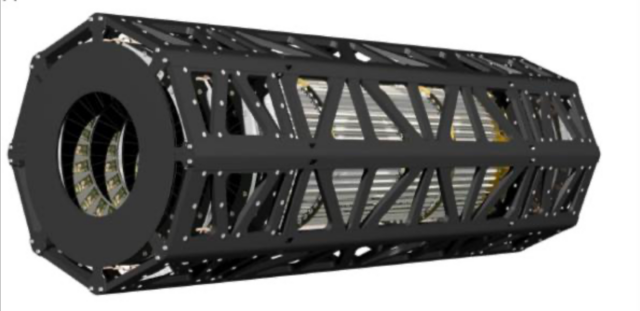
The design they came up with looked a bit like a miniature ATLAS—a 10-meter-long solenoid with a 3-meter inner radius and a hair above 6-meter outer radius hosting 12 racetrack superconducting coils. The habitable space was placed inside. The cooling problem was solved by using yttrium barium copper oxide, the first of ReBCO family of superconducting materials that worked above the boiling point of liquid nitrogen. This meant the entire system could be cooled with nitrogen rather than helium. The estimated weight was between 40 and 46 tons, depending on the magnetic field’s bending power. It offered a way to reduce the radiation dose by a factor of two.
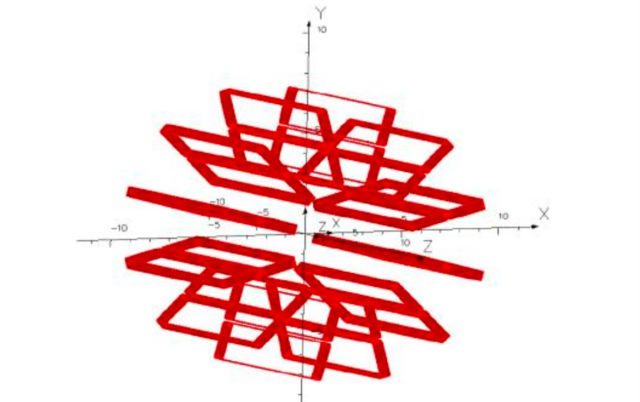
Space radiation superconducting shield
Preliminary designs done, ESA funded an even larger effort to build an active radiation shield called Space Radiation Superconducting Shield, or SR2S, this time with CERN and Thales Alenia, a European space industry giant, onboard. Battiston again took the helm as the project’s coordinator. The solenoid shield got more powerful—the bending power achieved in the most promising configuration grew from 5 Tesla/meter to 11.9 Tesla/meter, but it also grew heavier, hitting 100 tons—over 50 percent above the payload capacity of a Falcon Heavy.
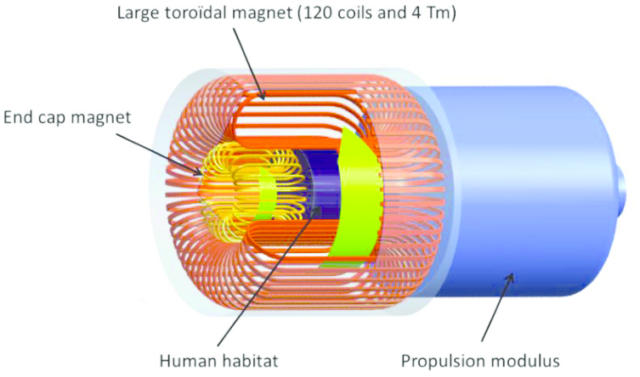
“The magnetic coils generate huge forces, and you need a supporting structure to keep these forces at bay. The stronger the magnets, the heavier the support structures must be, and [the support structure] causes secondary radiation.” Battiston said. When a high-energy particle flying in hits those supporting structures, it breaks down into three or four secondary lower-energy particles. The problem is one 100-GeV particle does way less damage to a human body than a hundred 1-GeV particles. “If the shield’s heavy, you are creating new particles at the same time as you are deflecting them away,” Battiston explained. So toward the end of the SR2S project, his team proposed a radically different design.
The new concept was called a pumpkin configuration, after the shape of the magnetic field it generated. It had three or four smaller shields installed around the spacecraft. The coils were arranged to balance out the forces they created, so the structure was mostly self-supporting. The pumpkin design matched the shielding efficiency of the best-performing solenoids at less than half their weight.
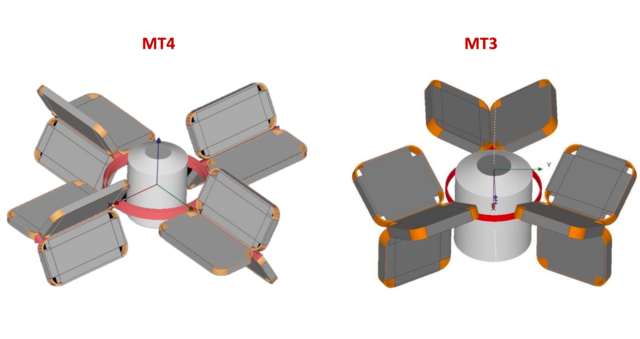
“At the end of the day, though, we are still talking about using roughly 40-ton shield to protect a module that weighs maybe 8 tons. It doesn’t add up. No space agency is currently considering putting a magnetic shield on a rocket because today we don’t have a good solution,” he said. The pumpkin idea, however, lived on to see another day.
NASA’s CREW HaT
In 2022, Elena D’Onghia and Paolo Desiati, scientists at the University of Wisconsin, submitted a magnetic shield project using a pumpkin-like configuration to NASA’s Innovative Advanced Concepts program and got funding. “Battiston’s conclusion was the same as always—active shields are way too heavy, but this is the best we can do at the moment,” said Desiati. “But in his report, he said that the future belonged to systems where magnetic fields are not confined in solenoids but are open into space. His team did provide some designs, but I have never seen dedicated technical studies. Our idea was to do such a technical study.”
CREW HaT stands for Cosmic Radiation Extended Warding Halbach Torus. It relies on eight magnetic racetrack coils made with ReBCO superconducting wires arranged to enhance the magnetic field outside the shielded habitat and suppress it inside. “It’s called the Halbach array. It’s used in maglev trains where you need the magnetic field only on the side facing the train, but don’t need it on the opposite side,” said Desiati.

Unlike the pumpkin design suggested by Battiston, CREW HaT is not self-supporting. Hoop stresses in the curved section of each individual coil reach 900 tons. They are contained by internal aluminum rib structures and Kevlar composites. Four coils facing the habitat with their flat side are expected to exert an outward force of about 85 tons. The remaining four coils exert an inward pressure on the structure, reaching 140 tons. These forces are counteracted by strong aluminum beams.
Overall, the CREW HaT team estimates its weight at a hair above 24 tons, and power requirements are a bit below 60 kW. “These are promising numbers. Passive shielding cuts roughly 20 percent of the particles hitting the spacecraft up to 500 MeV. CREW HaT adds another 50 percent on top of that. We are in the process of calculating everything precisely, but it is surprising that with such energies, we can achieve such shielding efficiency,” said D’Onghia.
60 kW, though, is the entire energy budget of the ISS, and it would need to go just into powering the shields. So, with nearly all the bets placed on next-gen superconducting magnets, NASA decided to try a different direction. In 2017, the Johnson Space Center and the Jet Propulsion Laboratory joined forces to launch their own active shielding project. And it turned out that electrostatic shields were way less dead than they appeared.
NASA’s active shield project
“When you look at literature on active shielding, the key takeaway is that such projects never make it out of what we call a paper study,” said Dr. Daniel Fry, a scientist working for the Space Radiation Analysis Group at NASA’s Johnson Space Center. So when he and Dr. Stojan Madzunkov, a scientist working at the JPL, started a new active shielding project, they opted for a more empirical approach.
“Stojan and I, we have always been experimentalists. We wanted to build small-scale shields, test them in a particle beam, learn how they function, and then scale them up to protect full-size spacecraft,” Fry said. This, in turn, pushed them toward electrostatic shields. “Simply because they are easy to do. You’re pretty much just flipping the power switch,” Fry added.
Electrostatics didn’t need advanced magnets, superconductors, or cryocooling systems. Instead, they relied on electrodes with positive and negative charges that created an electrostatic field that slows the incoming particles down and accelerates them away using the same force that makes your hair stand when you take off your sweater. On paper, they did the same thing as magnetic shields, but engineering-wise, they were entirely different.
“Take these solenoid designs. Your spaceship basically becomes an MRI tube. Like, how do you get out? And cryopumps are working all the time—clank, clank, clank—keeping liquid helium at 4 Kelvin,” said Madzunkow. And then there is quenching, which happens when part of a superconducting wire gets too hot and loses superconductivity. In a quench, all the energy accumulated in the coil is instantly released, which melts the wire and sends off a powerful electromagnetic pulse.
When a quench happened in the LHC’s superconducting magnets in 2008, its force was strong enough to squeeze and twist powerful steel hardware like it was made of paper. “You are surrounded by tons of liquid helium with a powerful magnet, and when it quenches, you are dead. That’s what they are talking about. Nobody would fly in that thing. It can kill you very, very badly,” Madzunkow said.
Electrostatic shields had been ignored because they required those 60 million volts that French and Levy talked about in their report. In 2008, NASA’s Kennedy Space Center and ASRC Aerospace Corporation proposed an electrostatic shield based on three huge Van de Graaff generators connected to an outer ring that looked like something taken straight from a Vulcan Combat Cruiser. It was undeniably cool, but it was completely infeasible. Fry and Madzunkow had to find something more realistic, so they turned to advanced modeling software and huge GPU clusters.
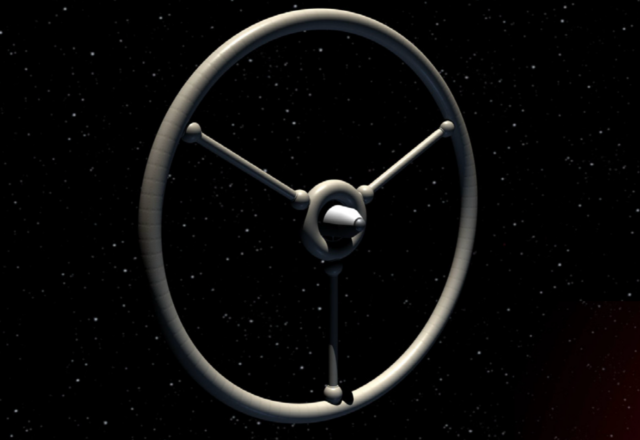
Electrostatic comeback
There are many things that shape electrostatic shields’ performance. You can use charged rods, spheres, planes, meshes—any imaginable combination of shapes and geometries. You then arrange them in a 3D space, which leaves you with another myriad of possibilities. You can then define different charges for each component. “The problem with choosing the right electrostatic shield configuration is that I could not pick the best one out of twenty just by looking at it. Not by a long shot. You only learn that when you run the numbers,” said Madzunkow. And there are lots of numbers to run.
First, the simulated space has to extend kilometers in every direction to fully model the unconfined electrostatic fields. You must then fill this space with millions of particles. “For each nanosecond, you need to calculate where each particle is, apply all the forces, and you do it again and again and again,” Madzunkow explained. “It wasn’t possible ten years ago. Testing just one configuration would take forever.”
So Fry’s and Madzunkow’s team developed their own simulation code called Active Shielding Particle Pusher, or ASPP. The ASPP was efficient and fast, and it used CUDA graphic card processing technology, allowing it to be run on clusters available at JSC and JPL. “Over 10 thousand independent simulations were done in two years,” said Fry.
This broad search yielded electrostatic shield configurations that could shield 50 percent of solar particle events’ radiation and 15 percent of cosmic rays using just 1 million volts, not 60 million. And you no longer needed to haul a full-size power plant with you. “Using grid-like, porous structures we not only brought the weight down, but we also brought the needed power down from megawatts to 100 watts,” said Fry. Power savings that big were possible because plasmas, which normally bleed away volts, did not accumulate on these porous structures—they flew right through them.
The electrostatic shields that emerged from Fry’s and Madzunkow’s simulations don’t look like rings in Vulcan cruisers anymore. Based on the scale-models, they will probably look more like large screens—similar to the anti-drone cages soldiers fit on their vehicles in Ukraine. “Such shields are not science fiction anymore,” Fry said.
The end of paper studies
Based on their simulations, Fry and Madzunkow built small-scale models of their electrostatic shields and tested them in a particle beam at Brookhaven National Laboratory with good results—they showed that the ASPP software was fairly accurate in its predictions. “We are at stage where we need to start looking at building larger demonstrators. Stojan and I proposed putting a device on a lunar surface as a technology demonstration for the plasma mitigation method. Sometimes, you’ve just got to focus on applications that perhaps you don’t want to do first,” said Fry.
Meanwhile, the CREW HaT team is working on cooling systems and improvements of superconducting coils. “There are different options, different pumps that need to be optimized for space. We are also designing the coils to optimize their superconducting properties as much as we can. Also, you don’t just wrap a superconducting tape around your racetrack coil. The winding has to have a very specific geometry. Our engineers are working on that like crazy,” said Desiati.
At the same time, on the other side of the Atlantic Ocean, ESA is also backing the development of superconducting magnets. Last year, Battiston’s team built YBCO coils and tested their currents, magnetic fields, and operating temperatures. Their next project looking into materials, superconducting wires, coil design, gluing, etc. will start in the coming months.
“Starship-type rockets could lift hundreds of tons to space. Maybe active shields could be done if rockets of this size become a reality,” Battiston said. “Also, cooling systems are responsible for most of the mass in magnetic shields, so our calculations will go out the window the moment we get room-temperature superconductors. There are hundreds of teams working on this around the world. Sooner or later, we’ll get there.”
Spaceflight Human-System Standard
But is “getting there” even worth it? ESA’s career radiation dose limit for astronauts is 1,000 mSv. Reference Mars mission scenarios estimate a total dose at a bit below 1200 mSv. That’s not that much of a difference—nothing you couldn’t fix by throwing a little more mass here and there in your spaceship. NASA had career limits dependent on sex and age, but you could probably get away with just picking old men for the job.
But then, on January 5, 2022, NASA revised Section 4.8.2 of the Spaceflight Human-System Standard and set the astronauts’ career radiation dose limit to flat 600 mSv. Active shields offer a roughly 50-percent dose reduction at a cost of huge mass penalty and development efforts. They have always ended up shelved because they were overkill. We just didn’t need that much protection. With NASA’s new standards, we ultimately might.
Source


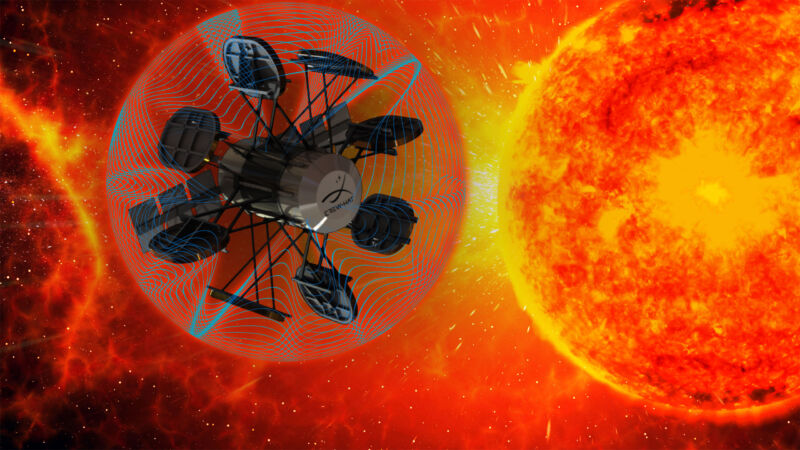
3175x175(CURRENT).thumb.jpg.b05acc060982b36f5891ba728e6d953c.jpg)






Recommended Comments
There are no comments to display.
Join the conversation
You can post now and register later. If you have an account, sign in now to post with your account.
Note: Your post will require moderator approval before it will be visible.